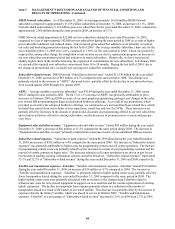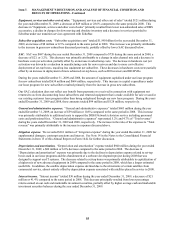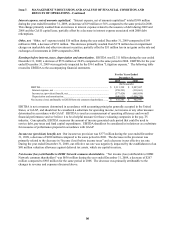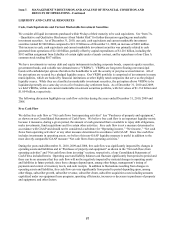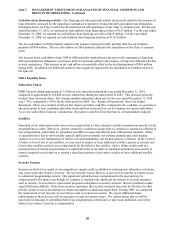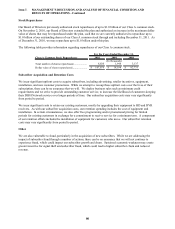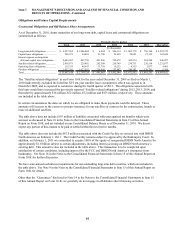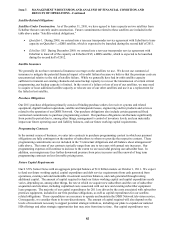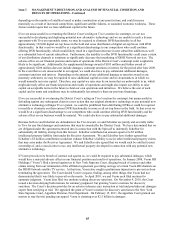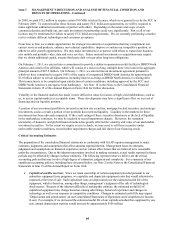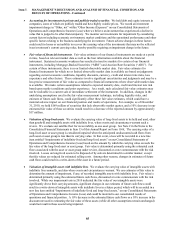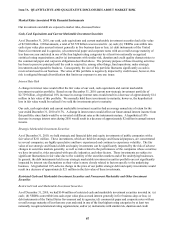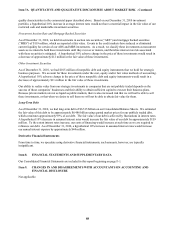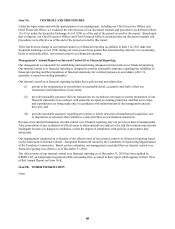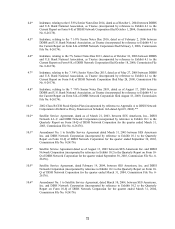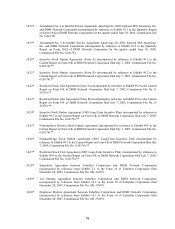Dish Network 2010 Annual Report Download - page 71
Download and view the complete annual report
Please find page 71 of the 2010 Dish Network annual report below. You can navigate through the pages in the report by either clicking on the pages listed below, or by using the keyword search tool below to find specific information within the annual report.Item 7. MANAGEMENT’S DISCUSSION AND ANALYSIS OF FINANCIAL CONDITION AND
RESULTS OF OPERATIONS - Continued
64
64
In 2008, we paid $712 million to acquire certain 700 MHz wireless licenses, which were granted to us by the FCC in
February 2009. To commercialize these licenses and satisfy FCC build-out requirements, we will be required to
make significant additional investments or partner with others. Depending on the nature and scope of such
commercialization and build-out, any such investment or partnership could vary significantly. Part or all of our
licenses may be terminated for failure to satisfy FCC build-out requirements. We are currently performing a market
test to evaluate different technologies and consumer acceptance.
From time to time we evaluate opportunities for strategic investments or acquisitions that may complement our
current services and products, enhance our technical capabilities, improve or sustain our competitive position, or
otherwise offer growth opportunities. We may make investments in or partner with others to expand our business
into mobile and portable video, data and voice services. Future material investments or acquisitions may require
that we obtain additional capital, assume third party debt or incur other long-term obligations.
On February 1, 2011, we entered into a commitment to provide a debtor-in-possession credit facility to DBSD North
America and certain of its affiliates, which will consist of a non-revolving, multiple draw term loan in the aggregate
principal amount of $87.5 million. On February 1, 2011, we entered into an investment agreement pursuant to
which we have committed to acquire 100% of the equity of reorganized DBSD North America for approximately
$1.0 billion subject to certain adjustments, including interest accruing on DBSD North America’s existing debt.
This transaction is to be completed upon satisfaction of certain conditions, including approval by the FCC and
DBSD North America’s emergence from bankruptcy. See Note 18 in the Notes to the Consolidated Financial
Statements in Item 15 of this Annual Report on Form 10-K for further discussion.
Volatility in the financial markets has made it more difficult at times for issuers of high-yield indebtedness, such as
us, to access capital markets at acceptable terms. These developments may have a significant effect on our cost of
financing and our liquidity position.
A portion of our investment portfolio is invested in auction rate securities, mortgage backed securities, and strategic
investments, and as a result a portion of our portfolio has restricted liquidity. Liquidity in the markets for these
investments has been adversely impacted. If the credit ratings of these securities deteriorate or the lack of liquidity
in the marketplace continues, we may be required to record impairment charges. Moreover, the sustained
uncertainty of domestic and global financial markets has greatly affected the volatility and value of our marketable
investment securities. To the extent we require access to funds, we may need to sell these securities under
unfavorable market conditions, record further impairment charges and fall short of our financing needs.
Critical Accounting Estimates
The preparation of the consolidated financial statements in conformity with GAAP requires management to make
estimates, judgments and assumptions that affect amounts reported therein. Management bases its estimates,
judgments and assumptions on historical experience and on various other factors that are believed to be reasonable
under the circumstances. Due to the inherent uncertainty involved in making estimates, actual results reported in future
periods may be affected by changes in those estimates. The following represent what we believe are the critical
accounting policies that may involve a high degree of estimation, judgment and complexity. For a summary of our
significant accounting policies, including those discussed below, see Note 2 in the Notes to the Consolidated Financial
Statements in Item 15 of this Annual Report on Form 10-K.
• Capitalized satellite receivers. Since we retain ownership of certain equipment provided pursuant to our
subscriber equipment lease programs, we capitalize and depreciate equipment costs that would otherwise be
expensed at the time of sale. Such capitalized costs are depreciated over the estimated useful life of the
equipment, which is based on, among other things, management’s judgment of the risk of technological
obsolescence. Because of the inherent difficulty of making this estimate, the estimated useful life of
capitalized equipment may change based on, among other things, historical experience and changes in
technology as well as our response to competitive conditions. Changes in estimated useful life may impact
“Depreciation and amortization” on our Consolidated Statements of Operations and Comprehensive Income
(Loss). For example, if we decreased the estimated useful life of our capitalized subscriber equipment by one
year, annual depreciation expense would increase by approximately $106 million.


